"We are what we repeatedly do. Excellence, then, is not an act, but a habit." --Aristotle
Address any questions or comments regarding this newsletter to the individual authors listed after each article or to its editor, Rick Weinzierl, 217-333-6651, weinzier@illinois.edu. To receive e-mail notification of new postings of this newsletter, call or write the same number or address.
In This Issue:
Upcoming Programs (listings for beginning and established growers)
Regional Reports (from southern and western Illinois)
Fruit Production and Pest Management (grape phylloxera)
Vegetable Production and Pest Management (day length and onion bulbing)
Upcoming Programs
Check the Illinois SARE calendar for a full list of programs and links for registration.
http://illinoissare.org/ and http://illinoissare.org/calendar.php
Also see the University of Illinois Extension Local Food Systems and Small Farms Team's web site at:
http://web.extension.illinois.edu/smallfarm/ and their calendar of events at http://web.extension.illinois.edu/units/calendar.cfm?UnitID=629.
- Hydroponics Workshop, May 13, 2015. 9:00 a.m. to 2:45 p.m. at Kankakee Community College, 100 College Dr., Kankakee IL 60901. Jeff Kindhart and Sam Wortman will provide an introduction to hydroponic systems. Cost: $10 per person. Lunch on your own. Link to be provided; call 815-933-8337.
- Southern Illinois Summer Twilight Series Meeting, May 18, 2015. 6:00 p.m. at Miller Farms, 918 Calvary Cemetery Rd, Campbell Hill, IL 62916. Visit a diverse farm operation that includes plasticulture strawberries, low tunnel tomatoes, blueberries, cover crops, egg production, and more. Program is free but pre-registration is required by Friday, May 15 online at https://web.extension.illinois.edu/registration/?RegistrationID=12224 or by phone at 618-382-2662. For more information about the Twilight Meeting go online or contact: Bronwyn Aly at baly@illinois.edu; 618-382-2662 or Nathan Johanning at njohann@illinois.edu; 618-687-1727.
- Southwestern Illinois Twilight Orchard Meeting, May 21, 2015. Weigel Orchard near Golden Eagle, IL, 5:30 – 7:30 p.m. For more information, contact Ken Johnson at 217-243-7424 or kjohnso@illinois.edu.
- Midwest Compost School, June 2-4, 2015. Wauconda Township Hall, Lake County, IL. For more information, contact Duane Friend at friend@illinois.edu or 217-243-7424. Register at http://extension.illinois.edu/go/midwestcompost.
- Illinois Summer Horticulture Day, June 11, 2015. 8:45 a.m. – 3:00 p.m. at Boggio's Orchard and Produce, 12087 IL Highway 71, Granville, IL 61326. Registration begins at 8:00 a.m. Advance registration is $25 and includes lunch. More information about Boggio's Orchard and Produce is available at www.boggiosorchardandproduce.com. Event information is available at http://www.specialtygrowers.org/illinois-state-horticultural-association.html. For questions and reservations, email Rachel at ilsthortsoc@gmail.com or call 217-853-6048.
Regional Reports
From southern Illinois ... The weather has been challenging for field work, with rain events in the past week and now cooler temperatures, with highs in the 60s. Last week there were patchy areas of frost, however, I have not heard of any reports of major crop injury.
Harvest of strawberries from plasticulture production began last week, and a few markets are open this week. Peaches are at shuck split, and apples are at petal fall. Later-maturing blueberry varieties are in full bloom and blackberries are starting to show flower buds, but bloom is still a few weeks away.
The first local greenhouse tomatoes are showing up on the market, and growers are gradually getting transplants out into the field as weather allows. Potatoes, onions, peas, radishes, spinach, lettuce, and other cool season crops have been planted. Cover crops are putting on lots of growth, with an early cereal rye variety already pushing out a head and crimson clover just starting to bloom in my cover crop plot in Jackson County.
Nathan Johanning (618-939-3434; njohann@illinois.edu)
From western Illinois … A frost event on the morning of April 23rd caught some early gardeners by surprise. Unprotected "warm season" plants such as tomatoes, peppers, eggplants, etc. were adversely affected, depending upon location (in town versus country, topography, etc.). Some reported loss of entire plants. Row covers and other devices were used to prevent damage and worked great. I recorded a low of 30 degrees that morning, and a light frost was evident throughout the farm. We did not get cold enough to damage emerged asparagus, however growth has been very slow. The "cold season" crops such as greens, onions, cole crops, etc. suffered no damage at all.
Rains on April 25-26 provided some relief from dry soil conditions. I received 0.6" of rain, which was welcome. Sweet corn planted April 6 emerged the weekend of April 18. It had a few days of nice warm weather to grow, but really hasn't done much for the past week. Looking at the base-50 growing degree day accumulation from April 20-27, it's pretty dismal, a total of 7. I think we're all looking forward to some warmer temperatures. However, due to the dry soil conditions, producers have been able to perform all the normal spring activities. All plantings have gone on as scheduled.
Peaches are at petal fall, and apples are still in bloom. Plasticulture strawberries are past half-bloom, and early-maturing matted-row strawberries are at bud stage; high tunnel strawberries are nickel size. Early-planted tomatoes in high tunnels are flowering, and a few are setting fruit.
There is quite a bit a variation across the state in precipitation amounts. Botrytis (gray mold) rot of strawberries can be a troublesome disease, especially when heavy precipitation accompanies bloom. It is most active at temperatures between 60-75 degrees. Leaf wetness is one of the key indicators to use in monitoring this disease. When bloom is occurring and leaf wetness duration exceeds 18 hours, the opportunities for Botrytis to infect are quite high. When leaf wetness duration is less than 13 hours at the same temperature and bloom is ongoing, the risk is very slight. Adjust your spray schedule to account for these differences.
I saw some peach leaf curl on a homeowner peach tree last week. Protection for this disease must occur prior to bud swell. Depending upon the severity of the disease, some leaf drop may occur or major leaf drop can occur. At this point there is nothing can be done to remedy the situation.
Mike Roegge (217-223-8380; roeggem@illinois.edu)
Fruit Production and Pest Management
Biology and Management of Grape Phylloxera
Grape phylloxera is a common and damaging pest of grapes throughout Illinois and the region. Overwintered eggs on grape trunks hatch in the spring, and immature stages called "crawlers" infest the first to third expanding terminal leaves. Leaves form a gall around each crawler. These crawlers mature to become egg-laying adults that produce 100 to 300 eggs each. Crawlers that hatch from these eggs crawl up to new terminal leaves and infest them (usually the 5th through 8th leaves on the shoot), often resulting in 50 or more galls per leaf. These crawlers are the targets of early season insecticide applications intended to reduce phylloxera damage. Timely application of effective insecticides are keys to controlling grape phylloxera.
A detailed guide to understanding and controlling grape phylloxera, Biology and Management of Grape Phylloxera, written by Dr. Donn Johnson, Sandra Sleezer, and Barbara Lewis of the University of Arkansas, is available online at http://www.uaex.edu/Other_Areas/publications/PDF/FSA-7074.pdf. Grape growers are urged to consult this publication, study its contents, and develop an effective management program. A degree-day model can be used to time sprays aimed at controlling the second generation crawlers that infest the 5th through 8th leaves. Start counting degree-days when the first leaves begin to expand on new growth. Using a threshold of 43 degrees F, the best timing of sprays intended to control second generation crawlers is at 550 to 800 degree-days. Listings of registered and effective insecticides for phylloxera control are on pages 18-20 and of the 2015 Midwest Small Fruit and Grape Spray Guide.
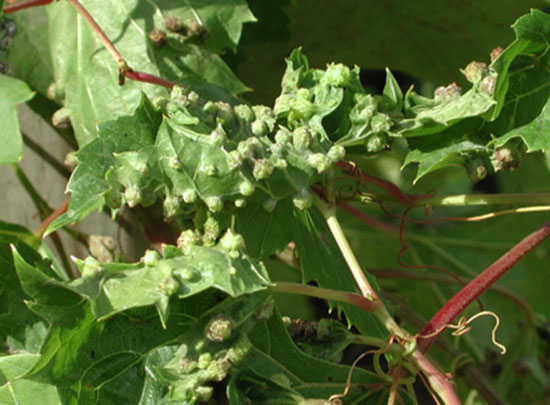
Grape phylloxera galls on leaves (University of Minnesota).
Rick Weinzierl (217-244-2126; weinzier@illinois.edu)
Vegetable Production and Pest Management
Day Length and Onion Bulbing
Our ultimate goal with growing onions is to have a healthy full bulb available for consumers to purchase. For onions to bulb properly, a number of factors are at play. One of the most critical of those factors is day length. Day length varies from a minimum of 9 hours and 14 minutes on about December 20 to a maximum of 15 hours 7 minutes on June 21 each year (at Galesburg, IL). When day length exceeds a critical duration, onion plants form bulbs. The storage type onions that we grow for market are typically "long-day" onions (for example 'Copra,' 'Patterson,' and 'Cortland'). These onions require day lengths of 14 hours or more for proper bulbing to take place. In western Illinois, day length reaches 14 hours around May 4 and drops back below 14 hours around August 10. From a practical standpoint, why does all this matter? As with any crop, timely planting means a great deal for crop success. Most onions should be in the ground by now. If not, and you plan to sell onions later this year, make it a high priority to get the crop established. Onions for transplant are typically one of the first crops that are started in late winter inside. If you have never started your own onions, give me a call, and I can help you walk through the process.
Kyle Cecil (309-342-5108; cecil@illinois.edu)
Soil-Heated Mini-Tunnels for Vegetable Transplant Production
There has been some renewed interest in producing bare root transplants (i.e. growing transplant starts in a field bed at close spacing, digging them out, and planting them into a field at normal spacing). Traditionally this has been done in field beds with crops that are cold-hardy, are not sensitive to excessive handling, and have a relatively shorter growing season. An example would be broccoli or scallion transplants started in a bed, dug out, and then transplanted into a field. For a more in-depth discussion on field-grown bare root transplants: http://atinadiffley.com/wp-content/uploads/Bare-Root-Transplants-.pdf .
In the passively solar heated conditions of a high tunnel, transplant start dates may need to be adjusted to account for the lack of soil temperature control that one can achieve in a fully automated greenhouse. However, most crops could be started this way, with the exception of vegetable crops sensitive to transplant shock (for example, cucurbits). Because tomatoes and peppers require higher soil temperatures to initiate germination, modifying a bare root system in a high tunnel or cold frame combined with heating the soil would be necessary for producing transplants of these crops.
In the figures below, a 4' x 8' soil-heated mini-tunnel is used for vegetable transplant production. The cost of such mini-tunnels varies from $12-$22 per square foot (excluding construction labor costs) … similar to the square-foot costs of automated, full-size greenhouses. The cost could be reduced if the mini-tunnel base were made out of wood instead of the aluminum double channel lock, but it would not last as long. Similarly, the auto-vent arm could be omitted and the tunnel vented manually. This 4'x8' mini-tunnel is heated from the bottom using electric warming cable (in this case, Gro-Quick Soil Warming Cable, 3.5 watts/foot). I used it to heat the soil in only half of the mini-tunnel. Another 2-inch layer of sand will be put on top of cable, followed by a protective hardware cloth, then potting soil mix. Seedlings are started in closely spaced rows, then "potted up" to other areas of the mini-tunnel at an increased spacing. The final transplants can be cut and lifted out of the potting soil like brownies from a cookie sheet.
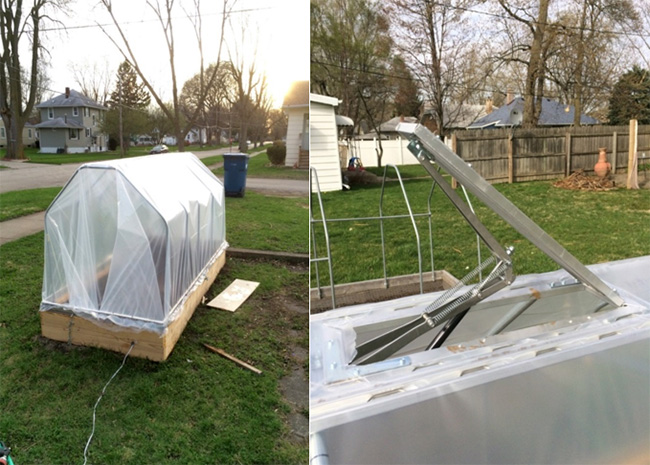
Left: ½" EMT hoops bent at two 45-degree angles to form a 4-foot wide hoop. These serve as the basic structure. Right: Automated vent arm to control temperature and humidity in mini-tunnel.
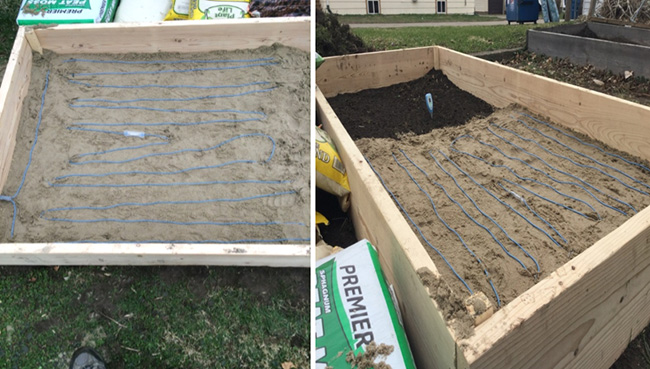
Soil heating cable on a 2-inch layer of sand
In preliminary un-replicated tests with this structure, I have been able to keep the soil on the heated side of the tunnel 10 degrees F warmer than the unheated side and 15-20 degrees F warmer than the outside soil temperature at a 2" depth. Sweet pepper seeds planted April 12 germinated in 12-13 days in this system. This is 4 to 5 days longer than the optimal "days to germination" for sweet peppers, but transplant dates could be adjusted to make this work. April 12 represents a late transplant start date for peppers, but had I started the process 2 weeks earlier, I expect the results would have been similar, as temperatures during this trial period dropped below freezing on some nights. Further study will reveal more details on how to best use small structures like this, but it seems to be an option for expanding transplant production space without investing in a larger greenhouse. This same approach could also be adapted to create a germination table within an existing transplant greenhouse. For a list of construction items used in this mini-tunnel and their costs, please contact me. I am also in the process of editing an instructional video for how to construct these mini-tunnels. (See https://www.facebook.com/UofILocalFoodsCookCounty.)
Zachary Grant (708-449-4320; zgrant2@illinois.edu)
Seed and Root Maggots
Early plantings of several vegetable crops are especially susceptible to damage by seedcorn maggot, cabbage maggot, or onion maggot. All of these species overwinter in the pupal stage, and adults of the first generation emerge in the spring. Flies prefer to lay eggs in fields where organic matter is high (recently incorporated manure or cover crops), and damage is greatest in cold, wet soils where plant growth is slowed.
Seedcorn maggots most commonly feed on the seeds and seedlings of corn, beans, peas, and cucurbits; they also may be found along with onion maggot or cabbage maggot infesting onions and plants in the cabbage family. Flies typically emerge in April and May, and females prefer to lay eggs in fields with abundant decaying organic matter. Peek emergence of flies occurs at 200 degree-days above a base of 39F (with accumulations beginning when ground has thawed); damage to seeds or seedlings is greatest over the 10 days after this peak. Larvae feed on decaying plant material in soils but also tunnel into seeds (and sometimes transplants) and reduce successful germination and stand establishment. Losses to seedcorn maggot can be reduced by incorporating manure or cover crops at least 3 weeks before planting or transplanting, preparing a well-tilled seedbed, and waiting until soil temperatures have warmed so that germination and early plant growth are rapid. Seeds or seed furrows can be treated to kill seedcorn maggot, and effective insecticides include diazinon, Lorsban, Capture LFR, and other products. Registrations differ by crop … see the 2015 Midwest Vegetable Production Guide for Commercial Growers and product labels for specific products and rates. Neonicotinoids used in seed treatments on cucurbits (Farmore DI-400) or in-furrow applications to soil (Admire Pro or Platinum) when cucurbits are planted or transplanted are not completely effective for seedcorn maggot control. Where damage results in reduced stands, replanting or resetting transplants can be done 4-5 days later without likelihood of damage to the new seeds or transplants.
First generation cabbage maggot flies also emerge in April or May, and they too prefer to lay eggs in soils with high amounts of organic matter. Peak flight of first generation flies occurs at 300 degree-days (base 43F) after March 1. Larvae tunnel into the roots and stems of cabbage, broccoli, Brussels sprouts, cauliflower, radishes, turnips, and rutabagas. Early cabbage and turnips are especially susceptible to injury. Damage is reduced by delaying planting and by avoiding fields with high amounts of fresh organic matter. Soil application of Capture LFR, Lorsban, or Diazinon provides effective control of first generation maggots for cabbage, broccoli, Brussels sprouts, and cauliflower, but these insecticides are not labeled for short-season crops such as radishes and turnips. Again, see the 2015 Midwest Vegetable Production Guide for Commercial Growers and product labels for specifics.
The first generation of onion maggot flies emerges in May and lays eggs at the base of plants, where larvae tunnel into underground portions of plants. Subsequent generations in July and August-September also damage onions. Cultural control of onion maggot centers on removing and destroying cull onions and rotating this year's plantings as far as possible from last year's. As onions mature, they are less susceptible to onion maggot infestation unless they are damaged by cultivation equipment. Soil applications of Lorsban can be used to control onion maggot in dry bulb onions, and soil applications of Diazinon may be used to protect green onions or dry bulb onions.
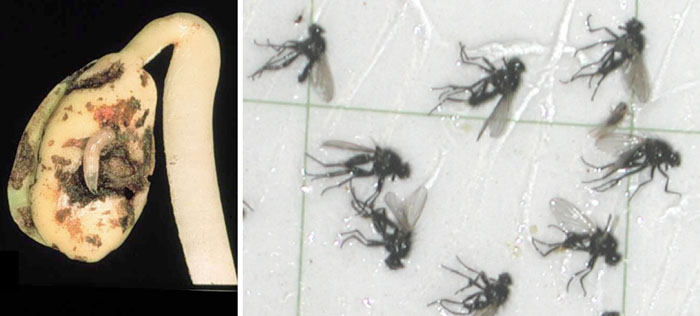
Left: Seedcorn maggot larva and damage (from E.A. Heinrichs et al., Maize Insect Pests in North America, at ipmworld.umn.edu/chapters/maize.htm). Right: seedcorn maggot adult flies (photo by Jeff Hahn at www.extension.umn.edu/.../YGLN-June1502.html).
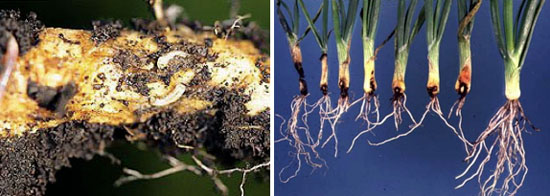
Left: Cabbage maggots on cabbage root. Right: onion maggot injury to green onions. (Photos from Universsity of Minnesota.
Rick Weinzierl (217-244-2126; weinzier@illinois.edu)
University of Illinois Extension Specialists in Fruit and Vegetable Production & Pest Management
Extension Educators – Local Food Systems and Small Farms |
||
Bronwyn Aly, Gallatin, Hamilton, Hardin, Pope, Saline, and White counties |
618-382-2662 |
|
Katie Bell, Franklin, Jackson, Perry, Randolph, & Williamson counties |
618-687-1727 |
|
Sarah Farley, Lake & McHenry counties |
847-223-8627 |
|
Nick Frillman, Woodford, Livingston, & McLean counties |
309-663-8306 |
|
Laurie George, Bond, Clinton, Jefferson, Marion, & Washington counties |
618-548-1446 |
|
Zachary Grant, Cook County | 708-679-6889 | |
Doug Gucker, DeWitt, Macon, and Piatt counties |
217-877-6042 |
|
Erin Harper, Champaign, Ford, Iroquois, and Vermillion counties |
217-333-7672 |
|
Grace Margherio, Jackie Joyner-Kersee Center, St. Clair County |
217-244-3547 |
|
Grant McCarty, Jo Daviess, Stephenson, and Winnebago counties |
815-235-4125 |
|
Katie Parker, Adams, Brown, Hancock, Pike and Schuyler counties |
217-223-8380 |
|
Kathryn Pereira, Cook County |
773-233-2900 |
|
James Theuri, Grundy, Kankakee, and Will counties |
815-933-8337 |
|
Extension Educators – Horticulture |
||
Chris Enroth, Henderson, Knox, McDonough, and Warren counties |
309-837-3939 |
|
Richard Hentschel, DuPage, Kane, and Kendall counties |
630-584-6166 |
|
Andrew Holsinger, Christian, Jersey, Macoupin, & Montgomery counties |
217-532-3941 |
|
Extension Educators - Commercial Agriculture |
||
Elizabeth Wahle, Fruit & Vegetable Production |
618-344-4230 |
|
Nathan Johanning, Madison, Monroe & St. Clair counties |
618-939-3434 |
|
Campus-based Extension Specialists |
||
Kacie Athey, Entomology |
217-244-9916 |
|
Mohammad Babadoost, Plant Pathology |
217-333-1523 |
|